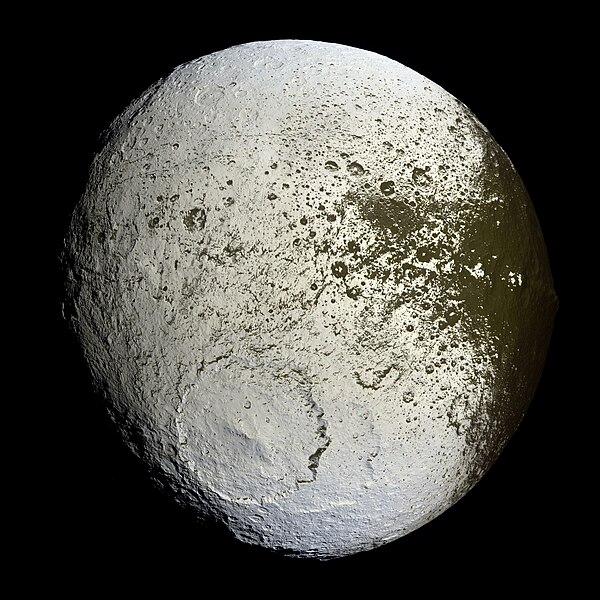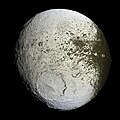Fail:Iapetus as seen by the Cassini probe - 20071008.jpg

Saiz pralihat ini: 600 × 600 piksel. Leraian-leraian lain: 240 × 240 piksel | 480 × 480 piksel | 768 × 768 piksel | 1,024 × 1,024 piksel | 2,048 × 2,048 piksel | 4,032 × 4,032 piksel.
Fail asli (4,032 × 4,032 piksel, saiz fail: 6.22 MB, jenis MIME: image/jpeg)
| Gambar ini merupakan gambar pilihan (Minggu ke-49 2013) Ini bermakna ahli masyarakat telah memilihnya sebagai salah satu gambar terbaik dalam Wikipedia Bahasa Melayu. Jika anda mempunyai satu imej yang berbeza dengan mutu yang sama, pastikan untuk muat naik imej tersebut dengan menggunakan teg lesen bebas, menambahnya ke rencana yang bersesuaian dan calonkannya. |
Sejarah fail
Klik pada tarikh/waktu untuk melihat rupa fail tersebut pada waktu itu.
| Tarikh/Waktu | Gambar kenit | Ukuran | Pengguna | Komen | |
|---|---|---|---|---|---|
| semasa | 18:07, 12 Disember 2018 |  | 4,032 × 4,032 (6.22 MB) | Kesäperuna | 100% JPEG quality from full quality TIFF, slightly cropped to be more centered. |
| 09:18, 9 Oktober 2007 |  | 4,100 × 4,100 (1.56 MB) | Startaq | {{Information |Description = Cassini captures the first high-resolution glimpse of the bright trailing hemisphere of Saturn's moon Iapetus. This false-color mosaic shows the entire hemisphere of Iapetus (1,468 kilometers, or 912 miles across) visible fro |
Penggunaan fail
11 buah laman berikut menggunakan fail ini:
- Iapetus (bulan)
- Sistem Suria
- Wikipedia:Calon gambar pilihan/2013
- Wikipedia:Calon gambar pilihan/Cadangan
- Wikipedia:Calon gambar pilihan/Minggu 27 hingga minggu 52 2013
- Wikipedia:Gambar pilihan/2013
- Wikipedia:Gambar pilihan/Angkasa lepas
- Templat:GP/Minggu 49 2013
- Templat:GP dilindungi/Minggu 49 2013
- Templat:Kotak bulan Iapetus
- Templat:SolarSummary
Penggunaan fail sejagat
Fail ini digunakan oleh wiki-wiki lain yang berikut:
- Penggunaan di af.wikipedia.org
- Penggunaan di an.wikipedia.org
- Penggunaan di ar.wikipedia.org
- Penggunaan di ary.wikipedia.org
- Penggunaan di arz.wikipedia.org
- Penggunaan di ast.wikipedia.org
- Penggunaan di az.wikipedia.org
- Penggunaan di ba.wikipedia.org
- Penggunaan di be.wikipedia.org
- Penggunaan di bg.wikipedia.org
- Penggunaan di bn.wikipedia.org
- Penggunaan di bn.wikibooks.org
- Penggunaan di bs.wikipedia.org
- Penggunaan di ca.wikipedia.org
- Penggunaan di ckb.wikipedia.org
- Penggunaan di cs.wikipedia.org
- Penggunaan di cv.wikipedia.org
- Penggunaan di cy.wikipedia.org
- Penggunaan di de.wikipedia.org
Lihat banyak lagi penggunaan sejagat bagi fail ini.



